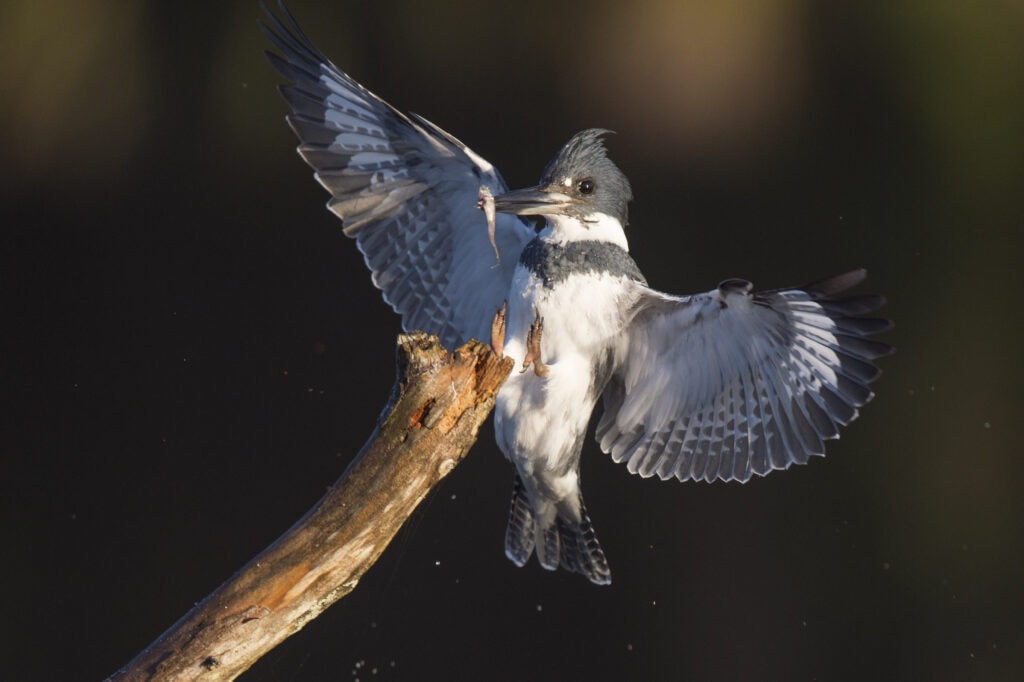The Belted Kingfisher is an iconic American bird with a range that extends from Alaska in the summertime, all the way down to the northern portions of South America. The Belted Kingfisher is a stocky bird with a large head, a thick sturdy bill, and a crest that gives it an instantly recognizable silhouette.
Though it is much smaller than the Bald Eagles or Ospreys that fish in American waterways, the regal bearing of the Belted Kingfisher lends credence to its name.
Related Article: Species Spotlight: The Greater Roadrunner
Fun Facts About the Belted Kingfisher
The Belted Kingfisher is a gorgeous animal and a beloved ambassador of America’s waterways. Let’s dive into some fascinating Belted Kingfisher fun facts!
Flashy females: It’s a well-known fact that in the world of birds, males tend to be extra flashy. From peacocks to birds of paradise, the typical type of avian sexual dimorphism — that is when the two sexes have visual differences — takes the form of a brightly colored or ornamented male and a more understated or drab female. Though it is more subtle than the difference between peacocks and peahens, Belted Kingfishers actually break this rule. Both males and females are a bluish gray color with a gray band at the breast. Female Belted Kingfishers have an additional rust-colored band beneath the gray one that gives them an extra pop of color.
Difficult digestion: Kingfishers are experts at fishing and much of their diet is composed of fish, though they do also eat amphibians, small reptiles, small mammals, and insects. They catch fish by waiting patiently and watching the water before diving to its surface and snatching their prey. They kill their prey by slamming them against their perch. This diet means they eat a lot of fish scales and bones. As young nestlings, Belted Kingfishers possess a powerful stomach acid that tackles these difficult to digest food items, but when they reach adulthood they can no longer handle it and instead regurgitate bones and scales in a similar fashion to owl pellets.
Bullet train bill: Though the Belted Kingfisher is an American species, kingfishers are also found in Asia, Europe, Africa, and Oceania. In Japan, kingfishers have the unique distinction of having inspired Japan’s famous Shinkansen high speed bullet trains. Despite diving at high speeds, kingfishers’ bills allow them to experience minimal wind resistance. The designers of the Shinkansen wanted to reduce noise and vibrations for their high speed trains, so they designed the shape to resemble a kingfisher’s bill. This pointed bill shape is aerodynamic and pierces the air bubble that forms in the front of a fast-moving train, preventing excessive noise.
The Future of the Belted Kingfisher
The Belted Kingfisher is listed as “Least Concern” by the IUCN Red List of Threatened Species. Their populations are considered stable, though habitat loss has contributed to decline in some areas. The Audubon Society predicts that Belted Kingfishers may lose range at rates of up to 16% if climate concerns worsen. The Belted Kingfisher depends on clean and healthy waterways to survive. Its future as a species is directly tethered to the future of America’s waterways and the wildlife that lives in and alongside them.
Popular Article: Facial Recognition Software Assists in Goose Conservation

